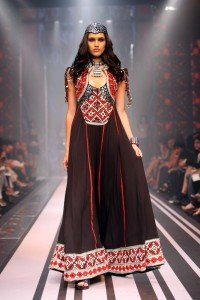Gypsy fashion has influenced designers such as Pria Kataria, Neeta Lulla, Vicky Martin Berrocal, Malini Ramani. Robert Cavelli, Anna Sui and especially Giorgio Armani’s 2008 fall collection.



What makes the gypsy style endure in fashion?

Whether it is layered skirts worn over leggings gathered on the bottom,

sequined shawls draped over ruffles and lace,


velvet and silk tunics under denim mirror embroidered boleros and cholis, head topped with feathered turbans,

with the jingle jangle of gold mixed with silver bangles, multi colored beads

and bells stringed with rope anklets
with tassels worn over boots…elements of Gypsy fashion is like the Gypsy migration, globally far reaching .

The appeal of this free spirited style in fashion signifies the romantic nomad,

the bohemian movement and the spill over from being displaced from one’s birthplace yet travelling wearing the past heritage mixed with current geographical trends.

Gypsies are the Roma, who originated from India and migrated to eastern Europe roughly a 1000 years ago.

Linguistic and genetic evidence marks the Romanies to have originated possibly from the Indian state of Rajasthan

then going northwest from the Punjab region then migrating to Europe possibly via Iran.

Perhaps through the glamour in the fashion designer’s aesthetic eye popularizing the Gypsy flair,


will some day lessen the discrimination that has been targeted to the Roma ethnic minority communities. Here are some pictures of actual Gypsies.The Kalbeliya and Bopa Women are the Gypsy Queens of India’s Rajasthan Desert. The Bopa are talented musicians and singers while the Kalbeliya are known as dancers and snake charmers.


The Gypsies have influenced the works of fashion designers bringing their style from the countryside to the catwalks and fashion runways.